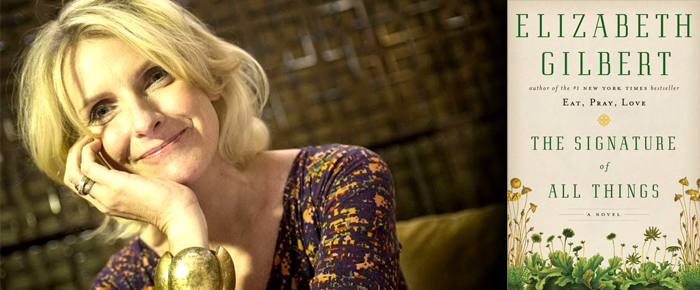
By Heidi Simmons
—–
The Signature of All Things
By Elizabeth Gilbert
Fiction
—–
Over ten million people in 30 countries read Elizabeth Gilbert’s memoir Eat, Pray, Love, a personal true tale in which she discovers the three essentials for a full and meaningful life. In her latest book, The Signature of All Things, (Viking, 501 pages) Gilbert reveals that she has provocative fictional stories to tell of equal gravitas.
Gilbert begins her epic novel with the protagonist’s grandfather who is known and respected for his ability to prune the Kew Garden apple trees. His son, Henry Whittaker, seeks out a better life for himself with the limited horticultural knowledge he has acquired from his father.
Sailing the world with Captain Cook, he learns first-hand about the medicinal benefits of plants. With no education or station in London life, he takes his knowledge and plants to America where he becomes the wealthiest man in Philadelphia, developing pharmaceuticals in the late 1700s. He and his noble-born Dutch wife start a family and together build a pharmacological empire.
Alma Whittaker is their beloved child and heir apparent. She is not beautiful; rather she is big, awkward and homely. But she is adored, respected and encouraged by her tenacious father and stern mother. Alma becomes a brilliant botanist who publishes her work and thirsts for more knowledge. She is strong and independent. Prudence, her adopted sister, is the antithesis of Alma. She is beautiful, obedient and quiet. The two siblings never really connect.
A modern woman, Alma learns to pleasure herself and longs for a husband so she can have sex. Enter Ambrose Pike, who seems to be a perfect man. He is a botanical artist and introduces Alma to a spiritual side of plants and life itself. Although 180 degrees from her work and thinking, his passion and commitment inspires Alma.
When they finally marry, she’s rejected sexually. Ambrose believes they are beyond the need for sex. Confused and hurt, Alma sends him to Tahiti where he later dies. Alma gives up everything and leaves her fortune and only home to understand her strange and estranged husband. Her journey ultimately leads her to learn more about herself and gives her a new appreciation for the mystery of life.
As part of the changing world, Alma’s character grows in the age of enlightenment and blossoms in the Industrial Revolution. She is a scholar whose work is compared to other great thinkers of the time. Alma makes mosses her specialty and she becomes a renowned expert. As a woman and scholar, Alma lives long enough to see her work accepted. She finds a family and place of peace.
Beyond the colorful generations, sibling melodrama and lost loves, Gilbert gives the reader insight to a world still developing thought and cultivating ideas. The word “science” is brand new in Alma’s time. She disagrees with the choice of word, thinking it too limited and narrow. She is a peer to Darwin and quietly competes with his notions. This is what makes The Signature of All Things so wonderfully layered and compelling. There is a philosophical and religious debate about the mystery of life, and how we humans define and contemplate life.
The title The Signature of All Things comes from a German naturalist, mystic and theologian named, Jacob Boehme, who believed God could be seen and known in all living things. Boehme’s De Signatura Rerum was written in 1621. The book was Ambrose’s favorite and he recommended it to Alma. Boehme alleged that God himself resided in the blossoms, fruit and trees. He believed there was a divine code and if you pay attention, you can see proof of the Creator’s hand. Ultimately, if one can perceive God in nature and creature, then one feels the highest virtue, which is Love. Alma wants to have and understand this love more than anything, even though it seems crazy.
Gilbert has gently and masterfully allowed this theme to seep through and take root in this colorful saga. She has written a detailed story rich in history, science and theology. Alma is a bold character who learns to appreciate not only the complexity of plants but also humans, which is not an easy lesson for her.
I wasn’t sure what I would find in the pages of Gilbert’s novel, but was pleasantly surprised to discover that the author is capable of delivering a well-written and thoughtful narrative in a big and unflinching way. Gilbert is not afraid to confront the challenges and mysteries of life through her characters. Eat, Pray, Love has not only enlightened and informed Gilbert, but her storytelling as well.












































